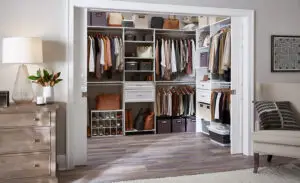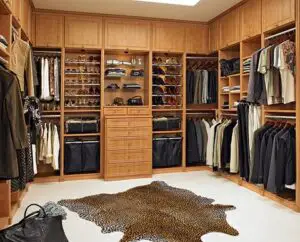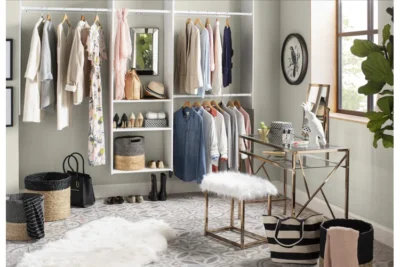Closet hangers come in various sizes and shapes, and their dimensions can make a significant difference in the organization and functionality of your closet space. Choosing the right hanger size and type and knowing the closet hanger dimensions can help you maximize your closet space and keep your clothes looking neat and tidy.
The standard width of a hanger is about 17 inches, which is wide enough to accommodate most clothing items. However, there are other sizes available, such as smaller hangers for children’s clothes or larger hangers for coats and jackets.
The length of the hanger also varies, with the standard length being around 14 inches. This length is suitable for most clothing items, but longer hangers may be necessary for coats, dresses, and other long items. Shorter hangers are also available for items like skirts and pants.
Standard Dimensions for Adult Clothing Hangers

The standard dimensions for adult clothing hangers are typically around 17 inches in width and 14 inches in length. This size is suitable for most adult clothing items, including shirts, blouses, and jackets. The hangers may have a curved shape to accommodate the shape of the garment and prevent stretching or sagging.
However, there are also variations in size and shape that are designed for specific types of clothing. For example, hangers for pants may be shorter and have clips or clamps to hold the pants in place. Skirt hangers may be narrower and have clips or adjustable bars to hold the skirt securely.
When selecting hangers, it’s important to consider the type of clothing you’ll be hanging and the amount of space you have in your closet. Choosing the right size and type of hanger can help keep your clothes organized and looking their best.
Children’s Clothing Hanger Dimensions
The dimensions for children’s clothing hangers can vary depending on the age range and size of the clothing being hung.
Here are some general guidelines:
- Infant hangers: These are typically the smallest size hangers and are designed for clothing sizes 0-12 months. The dimensions are usually around 10-12 inches in length and 5-6 inches in height.
- Toddler hangers: These are designed for clothing sizes 12-24 months and 2T-4T. The dimensions for these hangers are usually around 12-14 inches in length and 6-7 inches in height.
- Children’s hangers: These are designed for clothing sizes 4-8. The dimensions for these hangers are usually around 14-16 inches in length and 7-8 inches in height.
It’s important to note that these are just general guidelines, and there may be variations in size depending on the specific brand and style of the hanger. Additionally, some hangers may be adjustable in length to accommodate different sizes of clothing.
Dimensions of Hangers for Heavy Coats and Jackets
When it comes to hanging heavy coats and jackets, it’s important to use hangers that are strong enough to support the weight of the garment without bending or breaking.
Here are some general guidelines for the dimensions of hangers for heavy coats and jackets:
- Width: The hanger should be wide enough to fully support the shoulders of the coat or jacket. A good rule of thumb is to choose a hanger that is at least 1 inch wider than the width of the garment at its widest point.
- Thickness: The hanger should be thick enough to support the weight of the garment without bending or warping. Look for hangers made from sturdy materials such as wood or metal.
- Length: The length of the hanger will depend on the size of the coat or jacket. For a standard-size coat or jacket, a hanger that is 17-18 inches in length should be sufficient. For larger sizes, you may need a hanger that is 19-20 inches in length.
- Hook: The hook on the hanger should be sturdy and large enough to fit over the closet rod. A curved hook can help prevent the hanger from slipping off the rod.
It’s also a good idea to avoid using wire hangers for heavy coats and jackets, as they are not as strong and can bend or break under the weight of the garment. Instead, opt for hangers made from sturdier materials like wood or metal.
Hanger Dimensions for Pants and Skirts
For pants, the ideal hanger dimensions should be about 16-17 inches wide. This allows the pants to hang properly without getting creased or wrinkled. The hanger should also have a non-slip feature, like a rubber coating or grip strips, to keep the pants from sliding off.
For skirts, the ideal hanger dimensions depend on the type of skirt. For A-line or straight skirts, a hanger with a width of about 14 inches is recommended. For fuller skirts, a hanger with a width of about 17-18 inches is better. Again, it’s important to use hangers with non-slip features to keep the skirts in place.
Overall, the key is to use hangers that are appropriate for the type of clothing you’re hanging to prevent damage and keep them looking their best.
Space-Saving Hanger Dimensions for Small Closets

If you have a small closet and want to maximize space, you might consider using space-saving hangers. These hangers are designed to be slimmer than traditional hangers, allowing you to hang more clothing items in the same amount of space.
Here are some space-saving hanger dimensions that might work for you:
- Slim velvet hangers: These hangers are about 17.5 inches wide and 0.2 inches thick. They have a velvet coating that keeps clothing from slipping off.
- Cascading hangers: These hangers allow you to hang multiple items on one hanger, using vertical space instead of horizontal. The dimensions vary depending on the type of cascading hanger you choose.
- S-shaped hangers: These hangers are designed to hold multiple items on one hanger, with a curved shape that prevents clothing from getting wrinkled. They are typically about 13-14 inches wide and 0.3 inches thick.
Keep in mind that space-saving hangers may not be suitable for heavier items, like coats or suits, as they may not provide enough support. However, they can be a great option for lighter items like shirts, blouses, and skirts.
Hanger Dimensions for Scarves and Ties
For scarves and ties, there are several types of hangers available that can help keep them organized and easily accessible.
Here are some hanger dimensions that might work for you:
- Tie hangers: These hangers are typically about 6-7 inches wide and have multiple hooks or loops for holding ties. Some tie hangers also rotate for easy access.
- Scarf hangers: Scarf hangers can come in different shapes and sizes, but most have multiple loops or rings for hanging scarves. Some scarf hangers are about 10-12 inches wide and have 10-15 rings, while others are smaller with fewer rings.
- Hanger clips: If you have a regular hanger, you can also use hanger clips to hang scarves or ties. Hanger clips are typically about 2-3 inches long and can clip onto the bottom bar of a hanger. You can use multiple clips to hang several scarves or ties on one hanger.
Overall, the key is to choose a hanger that fits the size and shape of your scarves and ties while also allowing you to access them easily.
Specialty Hanger Dimensions for Delicate Clothing
When it comes to storing delicate clothing items such as silk blouses, cashmere sweaters, or lace dresses, using specialty hangers with appropriate dimensions can help to prevent damage and maintain the shape of the garments over time.
Here are some key considerations for choosing hangers for delicate clothing:
- Size: The hanger should be appropriate for the size of the garment, neither too small nor too large. A hanger that is too small can cause creases and distort the shape of the garment, while a hanger that is too large can stretch out the fabric and cause it to lose its shape.
- Shape: Some specialty hangers are designed with a specific shape to accommodate certain types of garments. For example, a hanger with curved arms can be ideal for supporting the shape of a blazer or jacket, while a hanger with a wide, contoured shoulder can be better suited for a dress or blouse.
- Material: Look for hangers made from materials that won’t damage delicate fabrics, such as wood, padded satin, or velvet. Avoid using wire or plastic hangers, which can leave marks or indentations on the fabric.
- Accessories: Some specialty hangers may come with accessories such as clips or hooks to help secure items in place or hang pants or skirts. Make sure any accessories are gentle and won’t damage the fabric.
By using appropriate specialty hangers for delicate clothing, you can help to preserve the quality and shape of your garments for years to come.
Hanger Dimensions for Plus-Size Clothing
Choosing the right hanger for plus-size clothing is important to ensure that the garment is properly supported and maintained.
Here are some key considerations for selecting hanger dimensions for plus-size clothing:
- Width: Plus-size clothing typically requires wider hangers to accommodate the additional fabric and weight of the garment. Look for hangers with a width of at least 18 inches or more.
- Shoulder slope: Hangers with a gentle slope help to support the shape of the garment without causing any stretching or distortion. This is especially important for plus-size clothing, as the additional weight can cause garments to lose their shape more quickly.
- Strength: Plus-size clothing can be heavier than smaller sizes, so look for hangers that are strong enough to support the weight of the garment. Consider hangers made of sturdy materials like wood or metal.
- Padding: Padded hangers can help to prevent creases and to stretch on delicate fabrics, such as silk or satin. If you have any plus-size garments made of delicate fabrics, consider using a padded hanger to help protect the garment.
By selecting hangers with appropriate dimensions for plus-size clothing, you can help to maintain the shape and quality of your garments, ensuring that they look great and last for many years to come.
Adjustable Hanger Dimensions for Growing Children
Adjustable hangers are a great solution for parents who want to keep up with their growing children’s clothing sizes without constantly buying new hangers.
To ensure that your adjustable hangers are suitable for your child’s changing needs, you should consider the following dimensions:
- Length: The length of the hanger should be adjustable to accommodate different clothing sizes. Ideally, it should be able to extend to at least 12 inches or more to fit larger clothing items.
- Width: The width of the hanger should be suitable for your child’s clothing items. Narrower hangers are better for smaller sizes, while wider hangers are better for larger sizes.
- Depth: The depth of the hanger should be adjustable to fit different thicknesses of clothing items. This is especially important for coats and jackets that may require a deeper hanger to prevent stretching.
- Weight capacity: The weight capacity of the hanger should be able to support the weight of your child’s clothing items without breaking or bending. Look for hangers that can hold at least 5 pounds or more.
By choosing adjustable hangers that meet these dimensions, you can ensure that your child’s clothes are always stored properly and efficiently, saving you time and money in the long run.
The Impact of Hanger Dimensions on Closet Organization

Hanger dimensions can have a significant impact on closet organization. Choosing the right hanger dimensions can help maximize closet space, keep clothing items organized, and prevent damage to clothes.
- Length:
Hanger length is important because it determines how much space clothing items take up in the closet. Longer hangers take up more space, which can be a problem in smaller closets. However, longer hangers are necessary for larger clothing items like coats and dresses. Adjustable hangers can be a great solution for accommodating different lengths of clothing.
- Width:
Hanger width should match the width of the clothing item. Narrower hangers are better suited for smaller clothing items like children’s clothes and tank tops, while wider hangers are necessary for larger clothing items like jackets and suits. Using the appropriate hanger width can help prevent creases and wrinkles in clothing.
- Depth:
Hanger depth is important for preventing stretching and damage to clothing items. Clothing items like coats and jackets require deeper hangers to prevent stretching and deformation of the fabric. It’s important to choose hangers with an appropriate depth to prevent damage to clothing items.
- Weight capacity:
Hanger weight capacity is important to prevent hangers from breaking or bending under the weight of heavier clothing items. Choosing hangers with an appropriate weight capacity can help prevent damage to clothing items and keep them organized.
How to Measure Hanger Dimensions
Measuring hanger dimensions is an easy process that can be done with a few simple tools. Here are the steps to measure hanger dimensions:
- Length: To measure the length of a hanger, use a measuring tape and measure from one end of the hanger to the other. Be sure to include any hooks or clips on the hanger in your measurement.
- Width: To measure the width of a hanger, use a measuring tape and measure from the widest point of the hanger. If the hanger has arms, be sure to include the width of the arms in your measurement.
- Depth: To measure the depth of a hanger, use a ruler or measuring tape and measure the distance from the back of the hanger to the front. This is especially important for thicker clothing items like coats and jackets.
- Weight capacity: To determine the weight capacity of a hanger, check the manufacturer’s specifications or use a digital scale to weigh the hanger. Subtract the weight of the hanger itself from the maximum weight capacity to determine the weight of clothing items the hanger can support.
It’s important to measure hanger dimensions accurately to ensure that you are choosing the right hangers for your clothing items. Using hangers that are the right length, width, depth, and weight capacity can help prevent damage to your clothes and maximize your closet space.
Choosing the Right Hanger Dimensions for Your Closet
Choosing the right hanger dimensions for your closet can help keep your clothing items organized, prevent damage to your clothes, and maximize your closet space.
Here are some tips for choosing the right hanger dimensions:
- Consider the type of clothing items you have:
Different clothing items require different hanger dimensions. For example, coats and jackets require deeper hangers to prevent stretching, while narrower hangers are suitable for shirts and blouses. Consider the types of clothing items you have in your closet and choose hangers with appropriate dimensions for each.
- Measure your closet space:
Before purchasing hangers, measure the available space in your closet to ensure that you choose hangers with appropriate dimensions that will fit your closet. If you have a smaller closet, choose hangers that take up less space, like narrow hangers. If you have a larger closet, you may be able to use wider hangers for larger clothing items.
- Look for adjustable hangers:
Adjustable hangers can be a great option for accommodating different clothing sizes and dimensions. Consider purchasing adjustable hangers that can be extended or compressed as needed to fit different clothing items.
- Check weight capacity:
Make sure to choose hangers with a weight capacity that can support the weight of your heaviest clothing items. Check the weight capacity of the hangers before purchasing, and consider choosing hangers with a higher weight capacity to be safe.
By choosing the right hanger dimensions for your closet, you can keep your clothing items organized, prevent damage to your clothes, and maximize your closet space. Be sure to consider the type of clothing items you have, measure your closet space, look for adjustable hangers, and check weight capacity when selecting hangers.
Recommended:
- How much does a treadmill weigh?
- How much does a squat bar weigh
- How much does a pallet of bricks cost?
- How much does a dumbbell weigh?
Common Mistakes When Selecting Hanger Dimensions
When selecting hanger dimensions, there are several common mistakes that people make that can lead to disorganization, damage to clothing items, and wasted closet space.
Here are some common mistakes to avoid when selecting hanger dimensions:
- Not considering the type of clothing item:
Different clothing items require different hanger dimensions. Using the wrong hanger dimensions can lead to damage or stretching of clothing items. For example, using narrow hangers for heavier clothing items like coats can cause stretching and deformation of the fabric.
- Not measuring closet space:
Not measuring the available space in your closet can lead to hangers that are too long or wide, taking up valuable closet space. Measuring your closet space before purchasing hangers can help ensure that you choose the right dimensions and make the most of your closet space.
- Not checking weight capacity:
Using hangers with a weight capacity that is too low for your clothing items can lead to broken or bent hangers, which can cause damage to clothing items. Always check the weight capacity of hangers before purchasing, and choose hangers with a weight capacity that can support the weight of your heaviest clothing items.
- Overlooking adjustable hangers:
Adjustable hangers can be a great solution for accommodating different clothing sizes and dimensions, but many people overlook them. Not using adjustable hangers can lead to disorganization and wasted closet space.
By avoiding these common mistakes, you can choose the right hanger dimensions for your closet, keep your clothing items organized, prevent damage to your clothes, and make the most of your closet space.
Conclusion
Choosing the right closet hanger dimensions for your closet is an important aspect of keeping your clothes organized and preventing damage to them. It is important to consider the type of clothing item, measure your closet space, check the weight capacity, and look for adjustable hangers to ensure that you choose the right hanger dimensions.
Avoiding common mistakes such as using the wrong hanger dimensions or not checking weight capacity can help you make the most of your closet space and keep your clothes looking their best.


